Armilite
Well-Known Member
- [h=1][FONT=ambroise-francois-std, Bodoni 72, Didot, Hoe*fler Text, serif]Why don't we have an Electric Ultralight Area?
[/FONT][/h]
WE FLY AN ELECTRIC AIRPLANE[/FONT][/h]

[FONT=ff-oxide-solid-web, OxideSolidOT, oxidesolidot-webfont, HelveticaNeue-Bold, Helvetica Neue Bold, Helvetica Neue, Helvetica, Arial, Lucida Grande, sans-serif]I’M ABOUT 600 feet above the Connecticut countryside, looking out over the fall colors of the valley below. I’m in the small, open cockpit of an ultralight with a stick in my right hand, rudder pedals at my feet and what feels like a throttle lever in my left hand.[/FONT]
But as much as the E-Spyder feels like a normal light aircraft, I have to remind myself that I’m flying an electric airplane. A[FONT=Exchange SSm 4i, ExchangeWeb-Italic, Exchange SSm 4r, ExchangeWeb-Roman, Georgia, serif]prototype[/FONT] electric airplane, one that only a handful of people in the world have flown. Tom Peghiny, the creator of this amazing aircraft, is watching anxiously from the ground, so I resist the urge to turn south and follow the ridgetops. Instead I stay close to the airport.
Electric flight is in its infancy. Only a handful of electric aircraft have ever flown, and beyond the designers, only a few other pilots have experienced the pleasure — and it is a pleasure — of flying purely on battery power. With that short list in mind, when Peghiny offered, I jumped at the opportunity to fly one of the only electric airplanes currently flying anywhere in the world.
Of course the current range of an electric airplane doesn’t make the technology a practical replacement for traditional small aircraft. But to focus on range is to miss the point. As of now, flying an electric airplane isn’t about going somewhere, just as flying an airplane in the decade after the Wright brothers first flight wasn’t about going somewhere.
It’s about the possibilities ahead.

Tom Peghiny provides a final review before the flight.
Flying on battery power is about the unique experience of flying without the noise, vibration and smells of a traditional engine pulling you along. It’s an entirely different sensation. And like gliding, it is about the challenge of flying within the limitations of the aircraft and maximizing your time aloft.
“It’s like hypermiling a flight,” Peghiny says.
Hypermiling was the furthest thing from my mind, however. My goal was to simply experience electric flight and keep enough energy in reserve to easily return to the runway and perform a go-around if needed.
To help me keep track of my “fuel” level, the second-generation E-Spyder prototype uses a digital display panel from Yuneec, the Chinese company that built the plane’s powertrain, including the motor, battery and controller. The panel displays battery voltage, propeller speed, battery discharge and power output.
Peghiny says the key to flying is watching the voltage. The 72-pound, 70-amp-hour lithium-polymer battery started the flight with 74 volts. Peghiny says I should be ready to land when it hits 65. Once I climbed to around 600 feet, I could pull back the controller to 1,800 rpm to minimize the drain on the battery. Full power is 2,200 rpm.
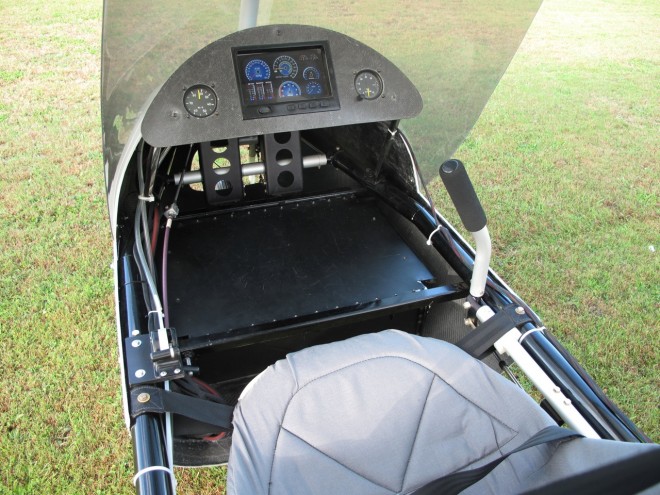
The simple cockpit of the E-Spyder with control stick on the right, power lever on the left. The battery is the floor.
I’m taking the plane out for its 11th flight. Peghiny made the first flight on this version just a month ago. This new design is essentially the production prototype, and I’m only the second person to fly it. And so my flight will be conservative. Nobody wants me exploring the limits of electric flight.
“You should climb out at about 40 miles per hour and cruise at about the same,” Peghiny tells me as I strap into the seat. “On final, fly it at 45 and remember it stalls at just 22.”
Once I’m buckled in, the magic of electric flight is immediately apparent. There is no need to prime the motor, work the throttle or adjust the mixture. There is no oil to check or fuel to sample. I simply verify charge levels after the self-diagnostic test is complete. With everything good to go, I move the small lever in my left hand forward. The propeller starts spinning with a gentle whir and I begin rolling forward.
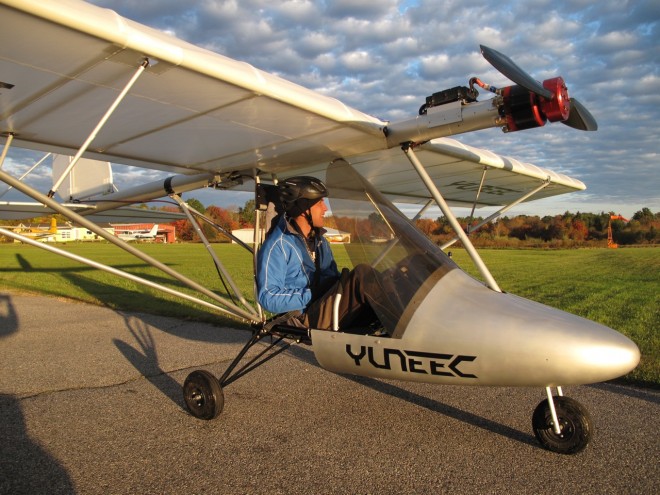
Getting ready to start the motor and taxi into position.
Anyone who’s driven a hybrid has grown accustomed to the silence of electric propulsion, but to experience it in an airplane is truly remarkable. Even while taxiing down the runway you instantly recognize that the sensations of electric flight are entirely new. There is no rumble of an engine at idle, or the noise of the typically lightly muffled airplane engine after pushing the throttle forward to start moving.
Instead, you sit in silence. When you taxi, there is the whir of the propeller and the quiet whine of an electric motor. When you stop at the end of the runway before taking off, everything goes silent again. I could actually hear birds chirping in the trees.

Taxiing the E-Spyder down the runway.
Development of the E-Spyder has been ongoing since Peghiny first met Chinese entrepreneur Tian Yu in the spring of 2009 at an aviation trade show in Europe. Yu, the founder of Yuneec, has built a booming business producing tiny electric remote control helicopters and airplanes.
Yuneec aimed to build full-size aircraft and already had a two-seat electric airplane in the works. But Yu also wanted to build a single-seat electric ultralight. He thought the Flightstar Spyder that Peghiny first developed in the early 1980s was a good candidate for electrification.
The two reached a handshake agreement to build a prototype and Peghiny immediately started to think about how his ultralight design could be adapted for electric flight. The motor, battery and controller arrived in Connecticut from China shortly after that first meeting.
Peghiny worked long hours before and after work fabricating parts, designing the battery and building his first electric airplane. He’s the president of Flight Design USA, the distributor for the CT series of light sport aircraft from Germany. I’ve known Peghiny for many years, primarily through his work with Flight Design. But his history in aviation goes back to even lighter aircraft including designing, building and flying hang gliders as a teenager, as well as a long history in the ultralight industry beginning in 1981.
To maximize performance, Peghiny knew he would have to make some changes to the Spyder. The original Spyder was designed to fly with a 35-horsepower, two-stroke gasoline engine. The Yuneec motor produces 20 kilowatts, or about 27 horsepower, so Peghiny knew he’d have to cut weight and minimize drag to maximize time aloft.
Working non-stop, Peghiny finished his first prototype in about five weeks. He made his inaugural flight the first flight of the first E-Spyder prototype just eight days before the big Airventure show in Oshkosh, Wisconsin last year.
“Oshkosh started on a Monday, we had to leave on a Thursday and it flew Sunday,” he says of the crazy week before the plane’s debut.
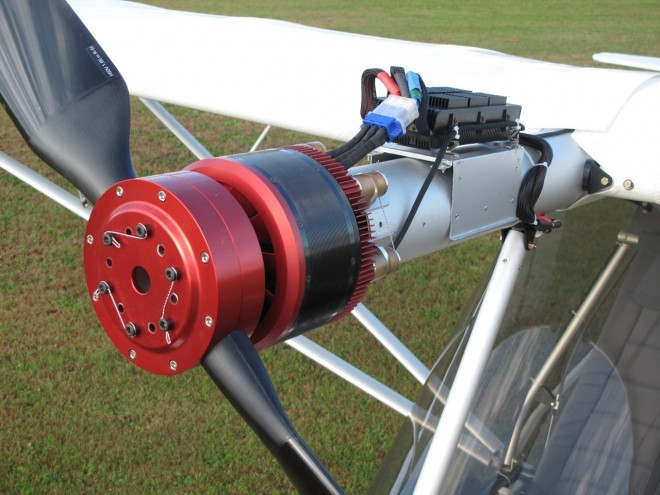
The 20-kilowatt (27-horsepower) electric motor and controller on the E-Spyder.
After flying almost every evening in Oshkosh, Peghiny returned home and immediately started making improvements to boost performance and flying time. At the end of last year, Yuneec bought the rights to the Spyder design from Flightstar and Peghiny continued work on the new prototype.
He moved the battery from an exposed position next to the motor to a spot behind the fairing just beneath the pilot’s legs to form the floor of the cockpit. He developed a new airfoil for the wing and increased the wingspan to 33 feet. New wing tips further improved efficiency.
Although the E-Spyder is by no means a high-performance sailplane, the revised wing design and relatively low wing loading should make it relatively easy to take advantage ofthermal lift and extend flight time by taking advantage of the free altitude.
Given the current limitations of battery range, Peghiny says the early adopters will have to think like birds.
“For a while with electric flight you’re going to have to think like a turkey vulture,” he says pointing to one circling near the airport. “If you want to go anywhere or do anything you’re going to have to have buoyant air.”
With an airplane like the E-Spyder, Peghiny says, you can use the motor to climb but the challenge will be soaring as much as possible.
“You’re going to power out of sink, and try to climb in lift,” he says. “That might be the sport of it.”
After lining up with the center of the runway, I push the power lever forward. The propeller whirs and I begin my takeoff roll. With the power lever all the way forward there is a gentle push in the first moment. But once the relatively large, 65-inch carbon fiber propeller gets a good bite, the torque of the electric motor provides noticeably quick acceleration.
I’m soon past take-off speed and at about 35 miles per hour, with a gentle pull of the stick I’m airborne — and climbing quickly for so small a plane. At full power, Peghiny says the E-Spyder can climb at 375 feet per minute. That won’t sound like much to an experienced pilot, but when your forward speed is only 40 mph, the climb-out angle is respectable.

The moment of liftoff during the first flight review of the E-Spyder electric airplane.
I want to climb to a safe altitude straight ahead, so I stay at full power for a couple of minutes until I’m at about 600 feet above the ground. There’s always wind noise when you’re moving along at 40 mph and there’s a little propeller blast moving past the fairing, but the overall sensation is very smooth and relatively quiet.
From the ground, there is virtually no sound when flying this high. After pulling the power lever back to 1,800 rpm, I find myself fighting the urge to go sightseeing. Instead I make a series of turns to get a feel for the airplane and simply enjoy the view. Flying the E-Spyder is like any other light airplane or ultralight.
The controls are very light and with full span ailerons combined with a relatively large rudder and elevator, the airplane is quite maneuverable. Of course, it’s [FONT=Exchange SSm 4i, ExchangeWeb-Italic, Exchange SSm 4r, ExchangeWeb-Roman, Georgia, serif]much[/FONT] lighter than a typical small Cessna 152 or even a Piper Cub, but flying it effectively feels the same. It flies like a normal airplane. The fact you’re powered by electricity is irrelevant as far as what you do while flying.
On the other hand, the sensation you feel while flying is unlike anything you’ve experienced. The sound is dominated by the air rushing by, there is no smell of gas or exhaust and no buzzing vibration being transmitted from the engine through the airframe.
Flying so smoothly and quietly makes you wish there were a bottomless battery available so you could fly around all day. But, for now, I have to remember to return to the airport. After a slow fly-by over the runway, I set up for my landing and a few minutes later I’m back on the ground touching down in a light crosswind.
There is still some power left in the battery, but despite the desire to take off once again and continue the quiet flight, I sit content knowing there will be more electric flights in the future.
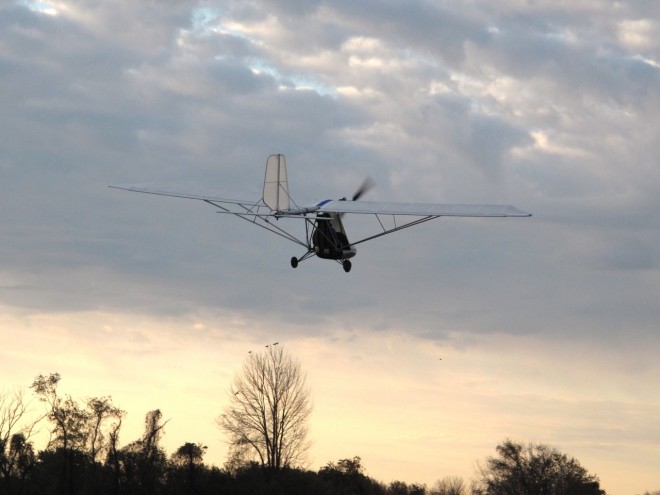
Flying into the sunrise on electric wings.
Peghiny has managed to get about 35 minutes of powered flight time with the second generation E-Spyder. He expects to increase that with further improvements, including a fairing behind the pilot to improve aerodynamics — and cutting weight further.
Yuneec plans to begin selling the plane early next year, and it will be offered in the United States by Flightstar USA. The expected price is around $27,000 including battery and a charger, about $8,000 more than the gasoline powered Spyder. FAA regulations do not require a license to fly an ultralight, Peghiny (and common sense) says prior flight experience or lessons are needed to safely fly the E-Spyder.
The electric airplane market is so small as to be insignificant, but Yuneec and others already have plans to sell more than electric ultralights. There even are plans for traditional two-seat aircraft that could be used as trainers for those seeking their private pilot license.
Tomorrow, we’ll look at some of the other designs, see what an electric flight school may look like and hear about the first person who learned how to fly entirely in an electric airplane.
[FONT=Exchange SSm 4i, ExchangeWeb-Italic, Exchange SSm 4r, ExchangeWeb-Roman, Georgia, serif]Photos: Jason Paur/Wired.com, Catherina Centanni[/FONT]
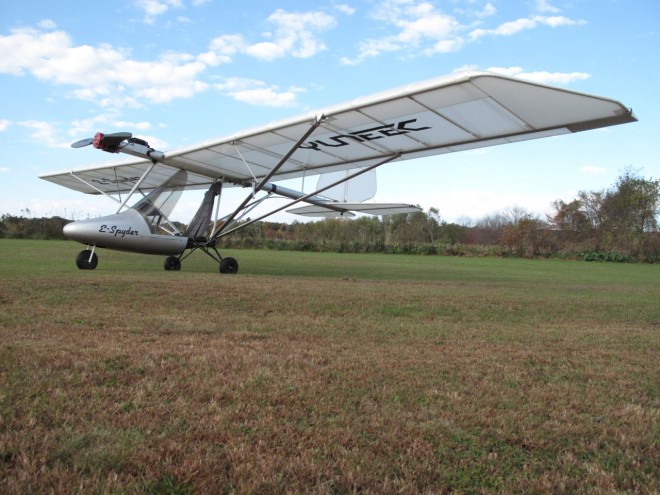
The new wing tips on the E-Spyder.
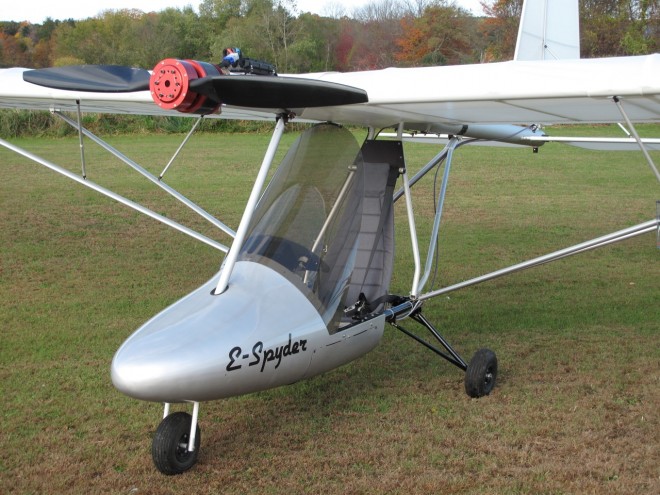
Future versions of the E-Spyder will include a fairing behind the pilot for improved aerodynamics.
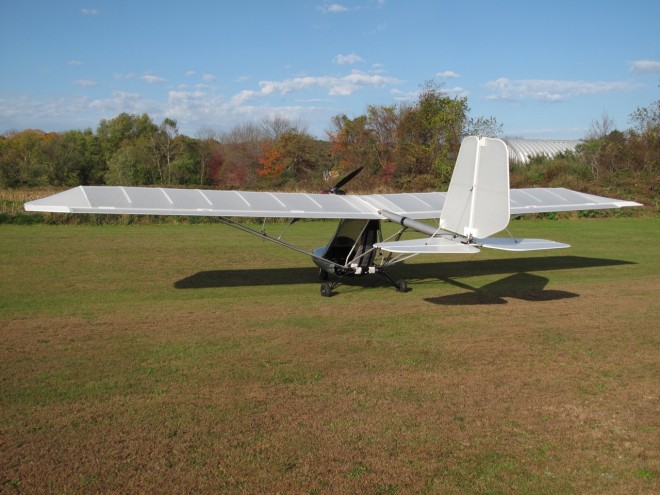
The bungee shock absorbers on the main gear are visible just behind the cockpit.
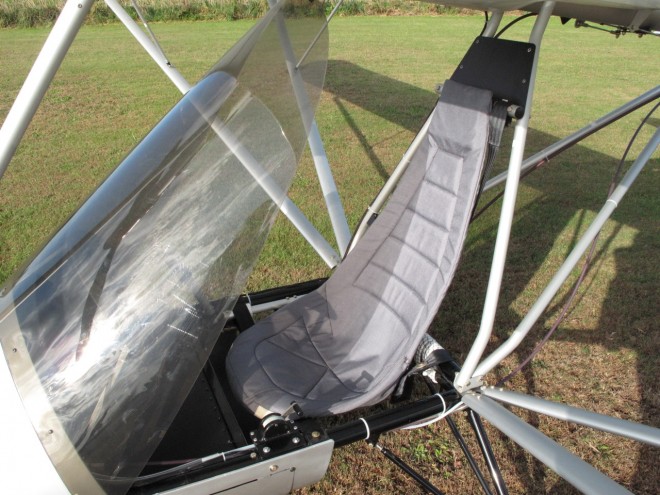
Nobody to elbow you while flying the E-Spyder.
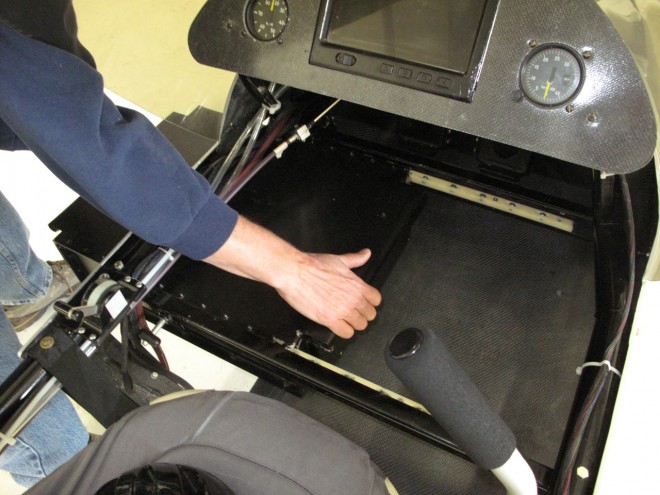
Removing the lithium-polymer battery from the E-Spyder Cockpit.
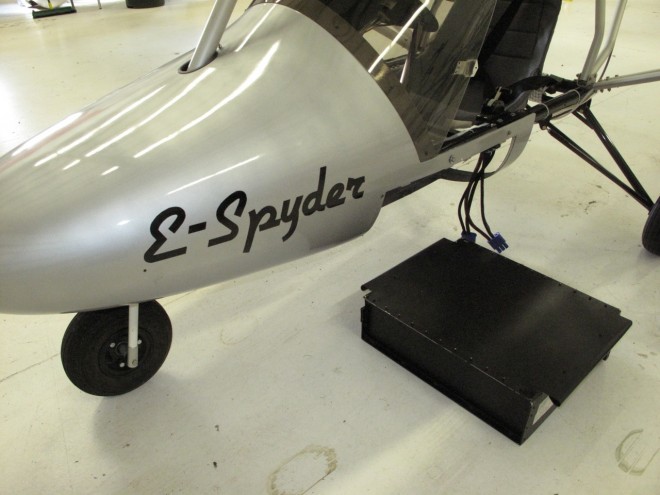
[FONT=brandon-text-wired, brandon-text, brandon-grotesque-1, brandon-grotesque-2, BrandonText-Bold, Gill Sans, HelveticaNeue-Bold, Helvetica Neue Bold, Helvetica Neue, Helvetica, Arial, Lucida Grande, sans-serif]Go Back to Top. Skip To: Start of Article.[/FONT]
The battery weighs 72 pounds and has a capacity of 70 amp-hours.




